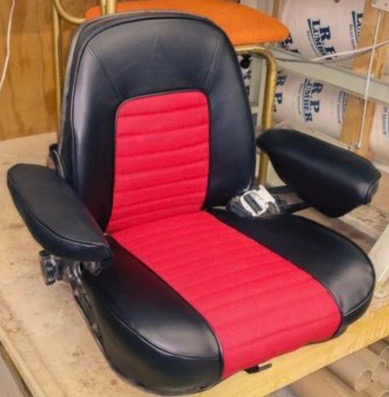| Author |
 Topic Search Topic Search  Topic Options Topic Options
|
jaybmiller 
Orange Level Access

Joined: 12 Sep 2009
Location: Greensville,Ont
Points: 24873
|
 Post Options Post Options
 Thanks(0) Thanks(0)
 Quote Quote  Reply Reply
 Topic: silo question Topic: silo question
Posted: 19 Mar 2020 at 6:22am |
OK, first day of Spring and I have a question... Is the grain stored in a silo just sitting there or does it ever get 'stirred' ? I'm thinkin if it's just there, eventually internal heat could get real hot. I can see tin silos heating up and 'cooking' the grain.
I know they 'grade' coal piles around
just curious....
|
|
3 D-14s,A-C forklift, B-112
Kubota BX23S lil' TOOT( The Other Orange Tractor)
Never burn your bridges, unless you can walk on water
|
 |
|
Sponsored Links
|
|
 |
AC7060IL 
Orange Level


Joined: 19 Aug 2012
Location: central IL
Points: 3603
|
 Post Options Post Options
 Thanks(0) Thanks(0)
 Quote Quote  Reply Reply
 Posted: 19 Mar 2020 at 6:39am Posted: 19 Mar 2020 at 6:39am |
|
Managing stored grain takes vigilance - either by person and/or sensors.
During the 1960s-70s, my Dad would keep tabs of air temps. In the fall, he’d run grain bin fans to cool down stored grain. That’d prep it for sub zero (F) winter temps. Depending on grains harvested moisture, he may only run aeration fan that may push dryer 40-60% humidity air into grain on dry days only. If storing grain a long time, then excessive dryness is usually a plus. If selling stored grain in short term (6-12 months), running aeration fans later, on humid day only, could add moisture & $$$$ to grain.
The lighter grain fines (chaff,pods,splits, etc) usually migrate towards the outer edges of moving grain. So these fines float to the outer wall of grain bin where the largest temperature differences occur. A large mass of grain becomes its own entity along with its own temp. Grain bin metal tin will transfer inside/outside temps very quickly. So much condensation (excess moisture) can occur inside the grain bin wall, hence the majority of spoiled grain is found there. Moving grain will cool it or help disperse any hot spots inside the grain mass. But any hot spots on the outer edges of the grain mass usually require a thorough bin cleaning.
Edited by AC7060IL - 19 Mar 2020 at 6:56am
|
 |
Calvin Schmidt 
Orange Level


Joined: 11 Sep 2009
Location: Ontario Can.
Points: 4573
|
 Post Options Post Options
 Thanks(0) Thanks(0)
 Quote Quote  Reply Reply
 Posted: 19 Mar 2020 at 6:46am Posted: 19 Mar 2020 at 6:46am |
First of all grain has to be properly dried and cooled to ambient before going into storage at harvest. It is then aerated with fans blowing air into the bottom to try to keep the grain near ambient temp. In the spring fans need to be run again to raise the grain temp and drive off any condensation. Steel bins take more air management in the spring because of convection currents with the sun beating on the south and the shade side being colder. Concrete grain silos are easier to manage because of the thermal buffering of the concrete walls. Most larger bins and silos have thermal cables hanging from the top to monitor the internal grain temp for hot spots. I've been building concrete grain silos all my working life with the next generation now in charge. The largest to date has been an 86' dia x 132' high holding approx 3000 acres of corn. Jay take a drive to P&H at pier 10 in Hamilton to see 15 of our silos.
|
|
Nothing is impossible if it is properly financed
|
 |
jaybmiller 
Orange Level Access

Joined: 12 Sep 2009
Location: Greensville,Ont
Points: 24873
|
 Post Options Post Options
 Thanks(0) Thanks(0)
 Quote Quote  Reply Reply
 Posted: 19 Mar 2020 at 6:56am Posted: 19 Mar 2020 at 6:56am |
Thanks guys ! follow up Q.... is the column of grain 'solid' or are there vertical tubes with holes to help areate the grain. I'm thinking Calvin's 86' round ones HAVE to have some way to disperse the airflow evenly ??
|
|
3 D-14s,A-C forklift, B-112
Kubota BX23S lil' TOOT( The Other Orange Tractor)
Never burn your bridges, unless you can walk on water
|
 |
AC7060IL 
Orange Level


Joined: 19 Aug 2012
Location: central IL
Points: 3603
|
 Post Options Post Options
 Thanks(0) Thanks(0)
 Quote Quote  Reply Reply
 Posted: 19 Mar 2020 at 7:16am Posted: 19 Mar 2020 at 7:16am |
|
I can only speak for the smaller farm grain bins(5000-50,000 bushel). These bin’s grain content is a solid mass with no vertical tubes. Their floors are slightly elevated(1-2’) to allow pressurized fan air to evenly fill under it. Then the floor is mostly perforated steel that allows pressurized air to flow evenly upwards thru solid grain mass. The pressurized air then exits via roof vents.
Edited by AC7060IL - 19 Mar 2020 at 7:17am
|
 |
FREEDGUY 
Orange Level Access


Joined: 15 Apr 2017
Location: South West Mich
Points: 5396
|
 Post Options Post Options
 Thanks(0) Thanks(0)
 Quote Quote  Reply Reply
 Posted: 19 Mar 2020 at 5:15pm Posted: 19 Mar 2020 at 5:15pm |
|
I could not imagine trying to control grain condition without Stirators of some type :-) YES, I've been on the outlet side of the unloading auger on a BTO's bins AFTER they had to enter with picks and sledge hammers to get the grain to finally go through the sumps :-(. Blending was the word of the month LOL!!
Edited by FREEDGUY - 19 Mar 2020 at 5:19pm
|
 |









 Topic Options
Topic Options

 Post Options
Post Options Thanks(0)
Thanks(0)


